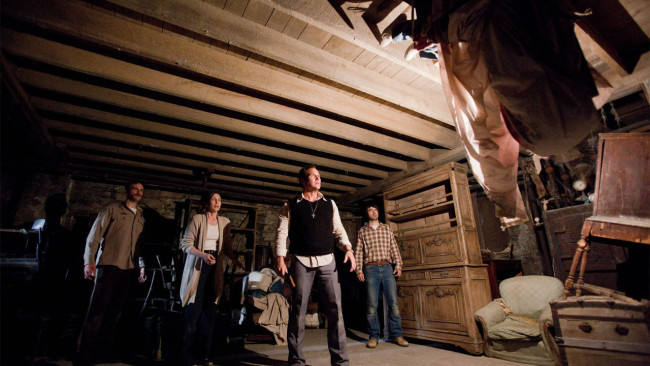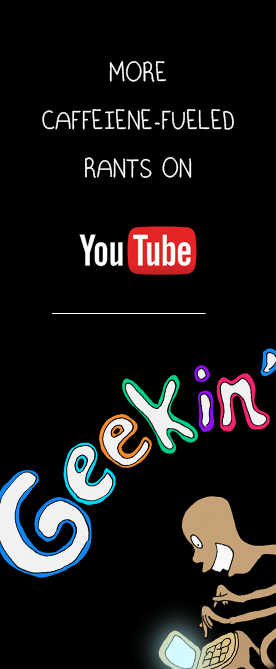The Conjuring
dir. by James Wan
The Warrens have got some spooky jobs: they’re ghost hunters. Ed and Lorraine Warren, a married couple with one very vulnerable child—hint, hint—go from one haunted house to the next fending off al of Satan’s surreptitious forces of evil. This isn’t a joke to them. It’s serious business. They’re just as ready to duel countless malevolent spirits to the death as they are to debunk the supposed hauntings with a little application of science and household engineering. Oh Horror! how you love your God versus science motifs!
On the other end of the story are Carolyn and Roger Perron (Lili Taylor and Ron Livingston, respectively) and their five girls. And they have a dog. But then they don’t. Catch my drift? The Perrons are a perfect blue collar family. The lone man on top, the patriarch Roger, hauls an 18-wheeler for Christ’s sake! The girls are beautiful and white, and still young enough for their deaths to cause trauma amongst mainstream audiences. Notice when the stakes are highest in the film: whenever Roger is gone hauling whatever it is he hauls for a living. The film’s best constructed, and most creative, sequence is when—Roger-less—Carolyn searches through her house, at night, with all the girls in bed, for an errant clap, clap. Carolyn thinks it’s one of her daughters up past her bedtime trying to get a game of “clap, clap” Marco Polo started. But all her daughters are asleep. Carolyn swears the claps are coming from downstairs. She goes down to investigate. The basement door creaks open on its own—as these things are apt to happen—and again: clap, clap. The scene only tightens its noose on you the further it unravels. Carolyn stumbles into the basement, wholly convulsed by the trembles of fear gripping her body, when, stuck in the dark and locked on the stairs with nothing but a box of matches to keep her company, she flicks a match into flame, lights the area immediately about her head, like a halo, and…clap, clap.
Ingenious!
The film’s patient. It burns slow. That scene of Carolyn locked in the basement is particularly horrifying due to its set up. More patient than one would assume—given his oeuvre—director James Wan (Saw, Insidious: Chapters 1 & 2) lets his horror breathe; he lets it worm its way into our heads and wriggle to that part of us that triggers our saliva glands whenever Pavlov’s bell dings. Only instead of the ding of a bell, we get a simple clap, clap. We see the girls play their game through the house early, not long after they move in. Then, after that, Wan treats us to another round, this one between Carolyn and her youngest. Carolyn is it, the blind searcher, while her daughter sets out to hide. Following her ears to her daughter’s room—you know, the one with the dresser big enough to hold a demon or two inside it—Carolyn asks for her last clap, and out of the dresser doors they come. But it isn’t in the form of Carolyn’s daughter’s hands, but rather the hands of someone older, meatier, and—most importantly—someone far deader. And just like that, with the introduction of the clap, clap, their association to the haunting, and the tension derived out of that association, Wan hits us hook, line, sinker. It took time, and a considerable amount of self-control, but Wan knew the scares would electrify the audience all the more with a Pavlovian undercurrent of structure. Signs of true discipline.
The period setting, 1971 Rhode Island, preemptively snuffs out any and all plot contrivances that might pop up in a typical modern-set Horror movie. Modern technology—with all that brainy, scientific science stuffed into the palm of our hands—dispels the mythology of all conventional Horror boogie men into the ether with the most cursory of Google searches. Technology trumps the supernatural. There’s a reason why cell phones still have to be “out of service” for anything freaky-deaky to happen in our Horror movies. Even works as good as HBO’s True Detective has fallen prey to such silly devices in lieu of organically-produced suspense. The Perrons don’t have anything more than a boob tube that quits working in the late night hours, let alone an iPad 2. What’s most important is the set design work by Julie Berghoff. You don’t doubt the furnishings for a second, the costumes, the hair—and that room with all of the Warrens’ formerly possessed bric-a-brac—their trophies of sort.
The Conjuring is an inherently silly movie, as are all Horror movies, but that’s part of the point. It’s supposed to be preposterous. For all us air-breathers here, I think it goes without saying, that death is a preposterous concept—unreal, otherworldly, too vague an idea for the brain to truly process—even though, internationally-speaking, this is the one thing we all have in common. Ah-hem! other than birth. But who remembers that? Anyhow, that’s what’s so fascinating about The Conjuring: its power to connect an entire crowd of strangers by the allure of death. I’ve never seen anything like it: grown-ass people sitting there with their eyes behind a lacework of fingers to protect them from the big, bad BOO! People screamed, shrieked, yelped, jumped, trembled, and prayed to the God Almighty up above—but then, as inevitably happened, they followed their act of cowardice with an embarrassed laugh, as if to say, “Oh my, was that me who just squealed like a bludgeoned banshee?” Hell, we were all guilty of it. It’s what bonded the us. The film’s rollicking fun spirit was so infectious, so energizing, and so inversely relaxing that people were turning to complete strangers and asking them, “Did you see that? Can you believe it?”
For the first time in a long time, I felt like I was watching true Summer popcorn fare—of the old variety. Like Jaws and Psycho before it, The Conjuring was more than a movie: It was an experience.
Check Us Out on Stitcher Radio






